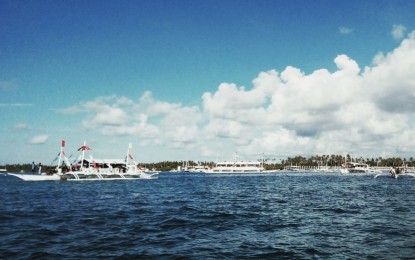
OLANGO ISLAND. A motorized pump boat crosses the seascape of Olango Island on its way to Mactan Island. Mayor Junard "Ahong" Chan said Friday (Aug. 28, 2020) Lapu-Lapu City is bent on repackaging Olango as an “ecotourism hub” in the Visayas, featuring its fishing and seaweed farming villages. (Photo courtesy of Olango Island Facebook page)
LAPU-LAPU CITY – The city government is bent on repackaging the Olango group of islands as an “ecotourism hub” in the Visayas, featuring its fishing and seaweed farming as an added tourist attraction.
Mayor Junard “Ahong” Chan said Friday that soon after the Inter-Agency Task Force for the Management of Emerging Infectious Diseases (IATF-EID) relaxes the quarantine status in this island city, they would drum up their marketing strategies for Olango.
“It will be a new travel escapade for our tourists. They will not just come to Olango just to dive, snorkel, or migratory-bird watching. They will be enticed with how the residents of Olango live as fishermen and seaweed farmers,” Chan told the Philippine News Agency (PNA) in an interview.
He noted that tourists around the world learn about the culture of places they visit, apart from enjoying the usual attractions, spots, hotels, restaurants, and shopping centers.
They are also attracted to the products grown or produced in a place, Chan said.
“Like in Olango, they will learn that the toothpaste they used, the ice cream they eat, the slippers they wear come from a product that Olagohanons are farming. And that is (the) ‘guso’ or seaweed,” he said.
Olango has 11 villages, eight of which – Baring, Caw-oy, Sabang, Santa Rosa, Talima, Tingo, Tungasan, and San Vicente – straddle the main island itself.
It has two satellite islets – Caohagan and Pangan-an – and another islet, Gilutongan, which is under the administrative control of the town of Cordova.
The island group has been known as one of the seven flyways in the world and its 920-hectare Olango Island Wildlife Sanctuary is a haven for birds migrating from Siberia, northern China, and Japan.
These birds flock to the island seeking refuge from other countries’ winter climate. Of the 97 species flocking to the island, 48 are migratory birds while the rest are native to the island.
Chan said apart from bird-watching, tourists visit Olango to swim and snorkel in its pristine beaches. Backpackers and adventure travelers also fancy rural life on the island.
“We are going to expand our port in Olango so that it can accommodate RoRo (roll-on/roll-off) vessels. In that, people can drive and bring their vans to Olango and enjoy sight-seeing. We are also working out with fast craft operators so that they can cross Olango in seven minutes from Angasil port,” he said.
The island can also be reached via a motorized pump boat from Angasil Port in Barangay Punta Engaño in this city.
It has two lodgings that have a combined bed capacity of 20 persons, apart from room spaces offered by the locals. Some investors plan to build more hospitality accommodations.
Chan said Olango would become “a new social media sensation” when people take their selfies on the island’s various spots and post them on Facebook, Instagram, and Twitter.
“That’s because our Internet connectivity is very reliable,” he said.
About 10,000 families stand to benefit once Olango turns into a new tourism escapade, Chan said.
The group of islands has a total land area of about 1,030 hectares and has sandy beaches, rocky shorelines, inshore flats, mangrove forests, coral reefs, and other marine features. (PNA)
